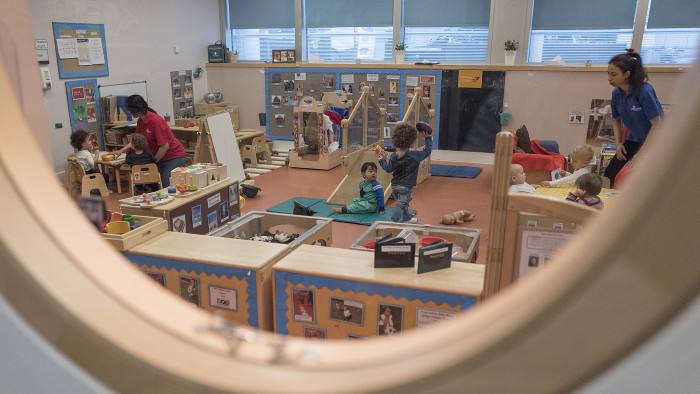On-site nurseries reap rewards for companies willing to invest

Roula Khalaf, Editor of the FT, selects her favourite stories in this weekly newsletter.
Lunchtime at Goldman Sachs and a group of messy eaters shovel food into their mouths before heading off to a darkened room for naps. With its grand, marbled corridors, it is hard to imagine that behind a secure door at the back of the investment bank’s central London office lies a world of story time, singsongs and creative play.
Goldman Sachs has run a partly subsided crèche on site since 2003, for children from three months to 12 years old. It serves mainly as a back-up for staff when usual childcare arrangements fall through. In 2010, it expanded to become a nursery with 48 full-time places.
Mitesh Popat, head of macro rates trading at Goldman Sachs’ asset management business, has been bringing his two-year-old daughter to the nursery for 10 months. His wife, Meera, a career coach in finance and consultancy, says the on-site nursery made her return to work after maternity leave possible.
“I was a contractor, so my roles came up quite quickly with little notice,” she says. “We didn’t like the nursery near our home that provided the appropriate hours. If it wasn’t for the [Goldman Sachs] children’s centre being able to take our daughter, it would have been a real challenge for us as a family.”
Rather than endure the London Underground, Mr Popat and his daughter take a 15-minute taxi ride to work. He used to catch up on emails but now “instead of numbers and spreadsheets, it’s nursery rhymes, the alphabet and pointing out how many buses she can count”, he says.
Mrs Popat’s latest job was in Canary Wharf, a tricky commute to the nursery, so she was able to save time by her husband doing the morning drop-offs.
The prospect of a gruelling commute with a buggy and small child in tow may explain in part why there are few on-site nurseries in central London. Outside the capital, the numbers are still thin. Just 5 per cent of businesses offer them, says the Chartered Institute of Personnel and Development, the UK professional body for human resources. They include Toyota and The Body Shop.
With UK workers commuting further distances in the search of somewhere affordable to live, many parents may prefer childcare to be closer to home, especially if they travel a lot, have family help nearby, or want to share drop-offs and pick-ups with their partners.
Carla Willmott, centre manager for the Goldman Sachs nursery, says many parents can avoid travel in the rush hour because of its extended opening hours of 7am to 6.15pm.
Childcare costs are higher in England for well-off couples than in any economically advanced country, according to the OECD. So companies that make the return to work easier for staff can expect motivated and loyal employees.
On World Book Day, Mr Popat squeezed in a visit to the nursery to read Dinosaur Rap to the children. But for Mrs Popat, who has just launched her own fashion line as a new venture, it was less easy to drop in during the working day.
Having more good nurseries near workplaces would help both parents, she says, “and would also hopefully mean that the pressure of childcare isn’t just on mothers”.
While there are both benefits and practical drawbacks to on-site nurseries, cost and liability also explain why they are rare, says Purnima Tanuku, chief executive of childcare charity National Day Nurseries Association. Many businesses might not have an appropriate space, for instance.
“The nursery sector is struggling and making a loss, so for employers it’s an expensive option and potential loss leader,” says Ms Tanuku.
Many businesses may prefer to look at other options to support working parents. Some organisations buy places at nearby nurseries so their staff have priority. Others join forces to run nurseries near their offices: Oxford university shares a nursery with pharmaceutical companies Evotec and Vertex.
Smaller businesses and start-ups with just a few employees might also consider co-working crèches, which are growing in popularity. These pay-as-you-go crèches, where parents drop their children off while they work in the same building, are also popular with self-employed parents because of their flexibility. With working parents often opting for part-time hours, competition for nursery places means it can be hard to get the exact days they require. Co-working crèches allow members to choose set hours, and the opportunity to alter them at short notice.
Another alternative is flexible working, says Claire McCartney, co-director of inclusive talent at CIPD. Allowing people to come in late or leave earlier, and demonstrating models of childcare that work for staff, are inexpensive ways to foster a family-friendly work culture, she says. “The private sector needs to up its game, particularly if it wants to attract and retain working parents, which is a high proportion of talent.”
Comments